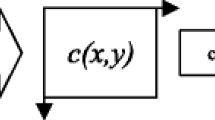Abstract
Discrete cosine transform (DCT) and its inverse (IDCT) play a key role in image and video systems. In this paper, we propose an efficient DCT/IDCT architecture based on adaptive recoding coordinate rotation digital computer (ARC), which has been validated on an FPGA platform. Compared to the state-of-the-art DCT, the proposed architecture dissipates 8.2% less power and improves PSNR by 3.21 dB while maintaining nearly the same area and speed. The proposed architecture uses 37.6% less hardware resources, saves 31.6% in power dissipation, provides a 2.15 times speed-up and improves PSNR slightly when compared with the newest DCT/IDCT architecture.
Access this chapter
Tax calculation will be finalised at checkout
Purchases are for personal use only
Similar content being viewed by others
References
Rao, K.R., Yip, P.: Discrete Cosine Transform: Algorithms, Advantages. Applications. Academic press, New York (2014)
Clarke, R.: Relation between the Karhunen Loèvet and cosine transforms. Commun. Rada Signal Process. IEE Proc. F 128(6), 359–360 (1981)
Wallace, G.K.: The JPEG still picture compression standard. IEEE Trans. Consum. Electron. 38(1), xviii–xxxiv (1992)
Le Gall, D.: MPEG: a video compression standard for multimedia applications. Commun. ACM 34(4), 46–58 (1991)
Ahmed, A., Shahid, M.U.: N point DCT VLSI architecture for emerging HEVC standard. VLSI Des. 2012, 6 (2012)
Li, C.-Y., et al.: A probabilistic estimation bias circuit for fixed-width booth multiplier and its DCT applications. IEEE Trans. Circuits Syst. II Express Briefs 58(4), 215–219 (2011)
Yu, S., Swartziander, E.: DCT implementation with distributed arithmetic. IEEE Trans. Comput. 50(9), 985–991 (2001)
Xiao, L., Huang, H.: A novel CORDIC based unified architecture for DCT and IDCT. In: 2012 International Conference on Optoelectronics and Microelectronics (ICOM). IEEE (2012)
Huang, H., Xiao, L.: CORDIC based fast radix-2 DCT algorithm. IEEE Sig. Process. Lett. 20(5), 483–486 (2013)
Huang, H., Xiao, L.: CORDIC based fast algorithm for power-of-two point DCT and its efficient VLSI implementation. Microelectron. J. 45(11), 1480–1488 (2014)
Huang, H., Xiao, L., Liu, J.: CORDIC-Based Unified Architectures for Computation of DCT/IDCT/DST/IDST. Circ. Syst. Sig. Process. 33(3), 799–814 (2014)
Lee, M.W., Yoon, J.H., Park, J.: Reconfigurable CORDIC-based low-power DCT architecture based on data priority. IEEE Trans. Very Large Scale Integr. (VLSI) Syst. 22(5), 1060–1068 (2014)
Zhang, J., et al.: Adaptive recoding CORDIC. IEICE Electron. Express 9(8), 765–771 (2012)
Meher, P.K., et al.: 50 years of CORDIC: algorithms, architectures, and applications. IEEE Trans. Circ. Syst. I Regul. Pap. 56(9), 1893–1907 (2009)
Xilinx, X.E.U.G., Xilinx power tools tutorial (2010). 2012
Zhang, J., Chow, P., Liu, H.: An efficient FPGA implementation of QR decomposition using a novel systolic array architecture based on enhanced vectoring CORDIC. In: 2014 International Conference on Field-Programmable Technology (FPT). IEEE (2014)
Acknowledgments
This work is supported by Xilinx. We also would like to thank Jianfeng Zhang and the reviewer for their revisions and suggestions.
Author information
Authors and Affiliations
Corresponding author
Editor information
Editors and Affiliations
Rights and permissions
Copyright information
© 2016 Springer Nature Singapore Pte Ltd.
About this paper
Cite this paper
Feng, Y., Zhang, J., Liu, H. (2016). A Novel Low-Power and High-PSNR Architecture Based on ARC for DCT/IDCT. In: Xu, W., Xiao, L., Li, J., Zhang, C., Zhu, Z. (eds) Computer Engineering and Technology. NCCET 2016. Communications in Computer and Information Science, vol 666. Springer, Singapore. https://doi.org/10.1007/978-981-10-3159-5_6
Download citation
DOI: https://doi.org/10.1007/978-981-10-3159-5_6
Published:
Publisher Name: Springer, Singapore
Print ISBN: 978-981-10-3158-8
Online ISBN: 978-981-10-3159-5
eBook Packages: Computer ScienceComputer Science (R0)





